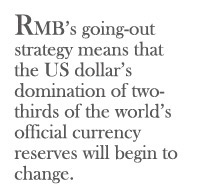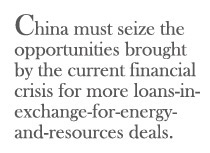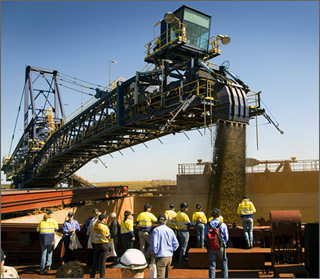Ironclad hedge: Chinese steel company, Hunan Valin Iron and Steel Group invests in Australian iron ore to diversify its holdings
EDMONTON, CANADA: With the global economy continuing to shrink and the outlook for a US recovery still gloomy, world attention has turned to
China. Its projected 6.5 percent growth and the $2 trillion foreign reserve make it appear as the likely savior of the global economy. But the Chinese government is preoccupied with a different agenda: how to protect its hard-earned savings from depreciation.
While the world seems to think of China’s huge currency reserve as a magic wand that can stimulate the global economy,
Beijing sees it more like the Sword of Damocles hanging over its head. The Chinese seem to have concluded that the international financial meltdown is threatening the security of their foreign reserve, seen by many as earned by the “blood and sweat” of hundreds of millions of low-paid Chinese workers. The debate is intensifying in China on how to enhance its financial position in a
US and Western dominated international system. And there are clear signals that the Chinese leadership has begun to take measure to address the problem.
 For most of the past three decades,
For most of the past three decades,
Beijing has pursued a modernization program largely built on traditional economic development models: heavy industrialization, labor- and capital-intensive manufacturing industries, export-led growth, low labor cost and high environmental damage. This program has ensured mass employment, albeit at a low wage, and dictated
China’s currency value remain low for most of the past 30 years. Rather than let the RMB’s exchange rate be decided by the market, the government set a fixed exchange rate by pegging the RMB to the dollar and periodically intervening to keep it low.
China’s trade and capital “twin surpluses” led to the accumulation of more foreign reserves over the years. Seeking safe investment returns for these reserves, Beijing began to purchase more and more US treasury bills, financing the US trade and budget “twin deficits,” and in the process, becoming the largest creditor of the
United States. Partly under US pressure to increase the value of RMB and partly due to its own concern over the danger of putting all its eggs in one basket, Beijing implemented a major reform in 2005 that halted the yuan’s peg with the dollar and instead adopted a floating exchange rate mechanism, pegging the Chinese currency to a number of currencies – a move away from the US dollar. Although the yuan’s value has gone up by 20 percent versus the dollar, the fundamentals of US-China economic relations have not changed.
 But the current US economic crisis and the Obama administration’s large spending approach to combating it leave China worrying about the value of its US dollar holdings. That is, the current huge
But the current US economic crisis and the Obama administration’s large spending approach to combating it leave China worrying about the value of its US dollar holdings. That is, the current huge
US foreign debt, the likely huge budget deficit in the future, and the large infusion of printed dollars are a recipe for inflation and thus the eventual deprecation of the US dollar.
China’s long-dreaded nightmare could come true: all its US dollar denominated assets, earned by “blood and sweat,” would plummet in value. The People’s Republic has become the
T-bills
Republic, as Nobel Prize winning economist Paul Krugman put it. Moreover, according to Krugman,
China has now fallen into a “US dollar trap” and cannot get out of it, nor will anyone come to its rescue.
So the Chinese are trying to rescue themselves by experimenting with two major measures. The first is to take steps to change the rules of the game altogether. Only days prior to the London G-20 summit, the Governor of China’s central bank Zhou Xiaochuan penned an article, blaming the US dollar’s position as a structural cause of the financial crisis and calling for the use of SDRs (IMF Special Drawing Rights) as a global super currency to replace the US Greenback. It stirred up some support and some controversy, with even the Chinese acknowledging that it’s a long shot.
 But
But
Beijing is not all talk and no action. Its first step in realizing such a fundamental change in the global financial order is to strengthen the RMB’s position. At the G-20 summit,
China indicated that it would inject $40 billion into the IMF, possibly in the form of purchasing the SDR bonds, thus pushing for IMF reform on its voting share. And since the second half of 2008, China has arranged and carried out currency swaps with many countries across the globe, worth over $120 billion, meaning
China’s trading activities will be using the RMB as a settlement currency instead of the dollar. Recently, Chinese Premier Wen Jiabao and other leaders called for closer cooperation among Asian countries through more currency swaps and new institutions. None of these are epoch making developments, but the RMB’s going-out strategy means that the US dollar’s domination of two-thirds of the world’s official currency reserves will begin to change.
Another effort by
China to pull itself out of the dollar trap is to diversify its global investment from low-return T-bills and volatile securities to energy and resource assets around the world. There is no central government body in charge of such a strategy. But newly announced policy measures, such as the Adjustment and Renewed Plan for the Iron and Steel Industries, have encouraged, and simplified procedures for overseas acquisitions by the Chinese enterprises. The prestigious Caijing Magazine has called the new wave of Chinese overseas acquisitions as a “grand concert without a conductor.”
 But the current world economic crisis has also presented opportunities with falling commodity prices and declining stock prices of many energy and resource companies. While still somewhat hesitant, some major Chinese companies seem to be on the move to increase their worldwide foreign direct investment portfolios. Leading the way are large Chinese mining companies, and the targets are primarily
But the current world economic crisis has also presented opportunities with falling commodity prices and declining stock prices of many energy and resource companies. While still somewhat hesitant, some major Chinese companies seem to be on the move to increase their worldwide foreign direct investment portfolios. Leading the way are large Chinese mining companies, and the targets are primarily
Australia’s mining sector. In February, Aluminum Corp. of
China invested $19.5 billion in Rio Tinto Group, now pending for Australian government approval. Canberra approved an A$1.3 billion investment by
China’s Hunan Valin Iron & Steel Group in Fortescue Metals Group Ltd.
In the energy sector, China has entered a new wave of large deal-making with major global players: It just signed a $25 billion agreement with
Russia, getting 15 million tons of crude annually for 20 years beginning in 2011 while providing the loans to Russian oil major Rosneft and the oil pipeline operator Transneft. Beijing has just concluded a $10 billion oil-for-loan deal with
Kazakhstan. Another $10 billion agreement with
Brazil’s Petrobras is under way. As the Deputy Minister of China’s National Energy Administration Sun Qin stated,
China must utilize its $2 trillion reserve to seize the opportunities brought by the current financial crisis for more loans-in-exchange-for-energy-and-resources deals.
Prominent Chinese economists like Yu Yongding and others have long called for moving away from US treasury bills and assets to investing more in tangible assets. It looks like
Beijing is now more determined than ever to avoid the trap of a “T-bills republic” and becoming instead a hard asset republic. Its challenge is to take just enough steps to walk away from the dollar but not too fast or too dramatic that may hurt the value of
China’s US dollar holdings.
China may not be doing what the world expects it to do but its tentative steps away from dollar dependence could help rebalance the world economy.

 For most of the past three decades,
For most of the past three decades,  But the current US economic crisis and the Obama administration’s large spending approach to combating it leave China worrying about the value of its US dollar holdings. That is, the current huge
But the current US economic crisis and the Obama administration’s large spending approach to combating it leave China worrying about the value of its US dollar holdings. That is, the current huge  But
But  But the current world economic crisis has also presented opportunities with falling commodity prices and declining stock prices of many energy and resource companies. While still somewhat hesitant, some major Chinese companies seem to be on the move to increase their worldwide foreign direct investment portfolios. Leading the way are large Chinese mining companies, and the targets are primarily
But the current world economic crisis has also presented opportunities with falling commodity prices and declining stock prices of many energy and resource companies. While still somewhat hesitant, some major Chinese companies seem to be on the move to increase their worldwide foreign direct investment portfolios. Leading the way are large Chinese mining companies, and the targets are primarily